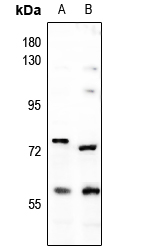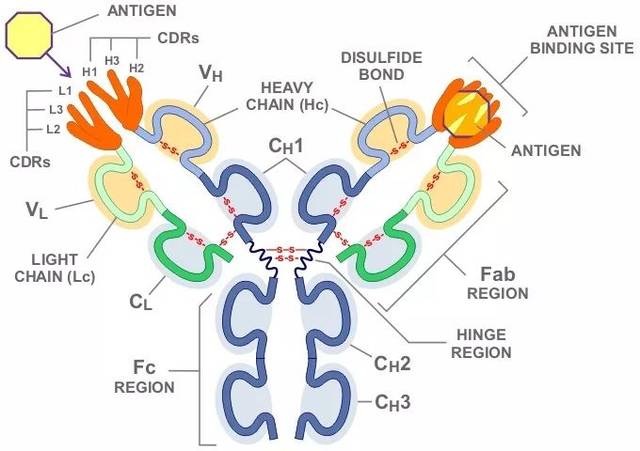Product Name :
DCLRE1B polyclonal antibody Background :
DNA interstrand cross-links (ICLs) pose lethal threats to DNA as they inhibit segregation, replication and transcription. The mechanism of ICL repair is complex but is at least partly conserved between Saccharomyces cerevisiae and mammals. SNM1B (SNM1 homolog B), also known as DCLRE1B [DNA cross-link repair 1B (PSO2 homolog, S. cerevisiae]) or APOLLO, is a 532 amino acid nuclear protein that localizes to discrete foci and is likely required for DNA interstrand cross-link repair. SNM1B assists in the maintenance of telomeres during S-phase and interacts with TRF2 (telomeric repeat binding factor 2), a protein involved in telomeric organization and protection, in the early DNA-damage response. A member of the DNA repair metallo-β-lactamase (DRMBL) family, SNM1B becomes phosphorylated following translation, either by ATM or ATR, and is encoded by a gene located on human chromosome 1. Product :
Rabbit IgG, 1mg/ml in PBS with 0.02% sodium azide, 50% glycerol, pH7.2 Storage&Stability :
Store at 4°C short term. Aliquot and store at -20°C long term. Avoid freeze-thaw cycles. Specificity :
DCLRE1B polyclonal antibody detects endogenous levels of DCLRE1B protein. Immunogen :
Synthetic peptide, corresponding to Human DCLRE1B. Conjugate :
Unconjugated Modification :
Unmodification
DCLRE1B polyclonal antibody Background :
DNA interstrand cross-links (ICLs) pose lethal threats to DNA as they inhibit segregation, replication and transcription. The mechanism of ICL repair is complex but is at least partly conserved between Saccharomyces cerevisiae and mammals. SNM1B (SNM1 homolog B), also known as DCLRE1B [DNA cross-link repair 1B (PSO2 homolog, S. cerevisiae]) or APOLLO, is a 532 amino acid nuclear protein that localizes to discrete foci and is likely required for DNA interstrand cross-link repair. SNM1B assists in the maintenance of telomeres during S-phase and interacts with TRF2 (telomeric repeat binding factor 2), a protein involved in telomeric organization and protection, in the early DNA-damage response. A member of the DNA repair metallo-β-lactamase (DRMBL) family, SNM1B becomes phosphorylated following translation, either by ATM or ATR, and is encoded by a gene located on human chromosome 1. Product :
Rabbit IgG, 1mg/ml in PBS with 0.02% sodium azide, 50% glycerol, pH7.2 Storage&Stability :
Store at 4°C short term. Aliquot and store at -20°C long term. Avoid freeze-thaw cycles. Specificity :
DCLRE1B polyclonal antibody detects endogenous levels of DCLRE1B protein. Immunogen :
Synthetic peptide, corresponding to Human DCLRE1B. Conjugate :
Unconjugated Modification :
Unmodification
-
 Western blot (WB) analysis of DCLRE1B polyclonal antibody at 1:500 dilution LaneA:A549 whole cell lysate LaneB:CT26 whole cell lysate
Western blot (WB) analysis of DCLRE1B polyclonal antibody at 1:500 dilution LaneA:A549 whole cell lysate LaneB:CT26 whole cell lysate
Bioworld Biotech only provide peptides for our antibodies and do not provide additional peptide customization services.
Price/Size :
USD 368/1mg/vial
Tips:
For phospho antibody, we provide phospho peptide(0.5mg) and non-phospho peptide(0.5mg).Describe :
Blocking peptides are peptides that bind specifically to the target antibody and block antibody binding. These peptide usually contains the epitope recognized by the antibody. Antibodies bound to the blocking peptide no longer bind to the epitope on the target protein. This mechanism is useful when non-specific binding is an issue, for example, in Western blotting (WB) and Immunohistochemistry (IHC). By comparing the staining from the blocked antibody versus the antibody alone, one can see which staining is specific; Specific binding will be absent from the western blot or IHC performed with the neutralized antibody.Formula:
Synthetic peptide was lyophilized with 100% acetonitrile and is supplied as a powder. Reconstitute with 0.1 ml DI water for a final concentration of 10 mg/ml.The purity is >90%,tested by HPLC and MS.
Storage:
The freeze-dried powder is more stable. For short time at 2-8°C. For long term storage store at -20°C.
Note :
This product is for research use only (RUO only). Not for use in diagnostic or therapeutic procedures.
 DCLRE1B polyclonal antibody
DCLRE1B polyclonal antibody  Datasheet
Datasheet COA
COA MSDS
MSDS SHIP
SHIP